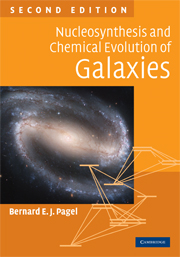Book contents
- Frontmatter
- Contents
- List of abbreviations
- Preface to the first edition
- Preface to the second edition
- 1 Introduction and overview
- 2 Thermonuclear reactions
- 3 Cosmic abundances of elements and isotopes
- 4 Cosmological nucleosynthesis and abundances of light elements
- 5 Outline of stellar structure and evolution
- 6 Neutron capture processes
- 7 Galactic chemical evolution: basic concepts and issues
- 8 Some specific GCE models and related observational data
- 9 Origin and evolution of light elements
- 10 Radioactive cosmochronology
- 11 Chemical evolution in other sorts of galaxies
- 12 Cosmic chemical evolution and diffuse background radiation
- Appendix 1 Some historical landmarks
- Appendix 2 Some physical and astronomical constants
- Appendix 3 Time-dependent perturbation theory and transition probabilities
- Appendix 4 Polytropic stellar models
- Appendix 5 Dissipation and abundance gradients
- Appendix 6 Hints for problems
- References
- Index
5 - Outline of stellar structure and evolution
Published online by Cambridge University Press: 05 June 2012
- Frontmatter
- Contents
- List of abbreviations
- Preface to the first edition
- Preface to the second edition
- 1 Introduction and overview
- 2 Thermonuclear reactions
- 3 Cosmic abundances of elements and isotopes
- 4 Cosmological nucleosynthesis and abundances of light elements
- 5 Outline of stellar structure and evolution
- 6 Neutron capture processes
- 7 Galactic chemical evolution: basic concepts and issues
- 8 Some specific GCE models and related observational data
- 9 Origin and evolution of light elements
- 10 Radioactive cosmochronology
- 11 Chemical evolution in other sorts of galaxies
- 12 Cosmic chemical evolution and diffuse background radiation
- Appendix 1 Some historical landmarks
- Appendix 2 Some physical and astronomical constants
- Appendix 3 Time-dependent perturbation theory and transition probabilities
- Appendix 4 Polytropic stellar models
- Appendix 5 Dissipation and abundance gradients
- Appendix 6 Hints for problems
- References
- Index
Summary
Fred Hoyle: Basically speaking a star is a pretty simple structure. R. O. Redman: Fred, you'd look pretty simple at a distance of 10 parsecs!
Overheard at Cambridge Observatory Club c. 1954.Introduction
A star is a ball of gas held in static or quasi-static equilibrium by the balance between gravity and a pressure gradient. The pressure can in general be supplied by one or more of a hot perfect ionized gas, radiation and a degenerate electron (or neutron) gas, depending on circumstances. For main-sequence stars like the Sun, nuclear reactions maintain stability over long periods and the pressure is predominantly that of a classical gas at water-like densities. For much larger masses (above about 100 M⊙), radiation pressure leads to instabilities, while for much smaller masses (below about 0.08 M⊙) the central temperature never becomes high enough to ignite hydrogen and the star slowly contracts releasing gravitational energy until halted by degeneracy pressure at densities ∼103 gm cm−3; such stars are called ‘brown dwarfs’. Below about 10−3M⊙ (the mass of Jupiter), ordinary solid-state forces take over from electron degeneracy pressure in supporting the body against gravity at water-like densities, giving a planet rather than a star. The formation of stars is a complicated process, many aspects of which are still poorly understood although it is observed to happen in dense, dusty molecular clouds. A basic concept is the Jeans instability in a uniform medium: gravitational collapse occurs on length scales λ ≥ λJ (the ‘Jeans length’) such that the propagation time for pressure waves λ/cs exceeds the free-fall time (Gρ)−½, where cs is the sound speed and ρ the density.
- Type
- Chapter
- Information
- Nucleosynthesis and Chemical Evolution of Galaxies , pp. 152 - 205Publisher: Cambridge University PressPrint publication year: 2009



